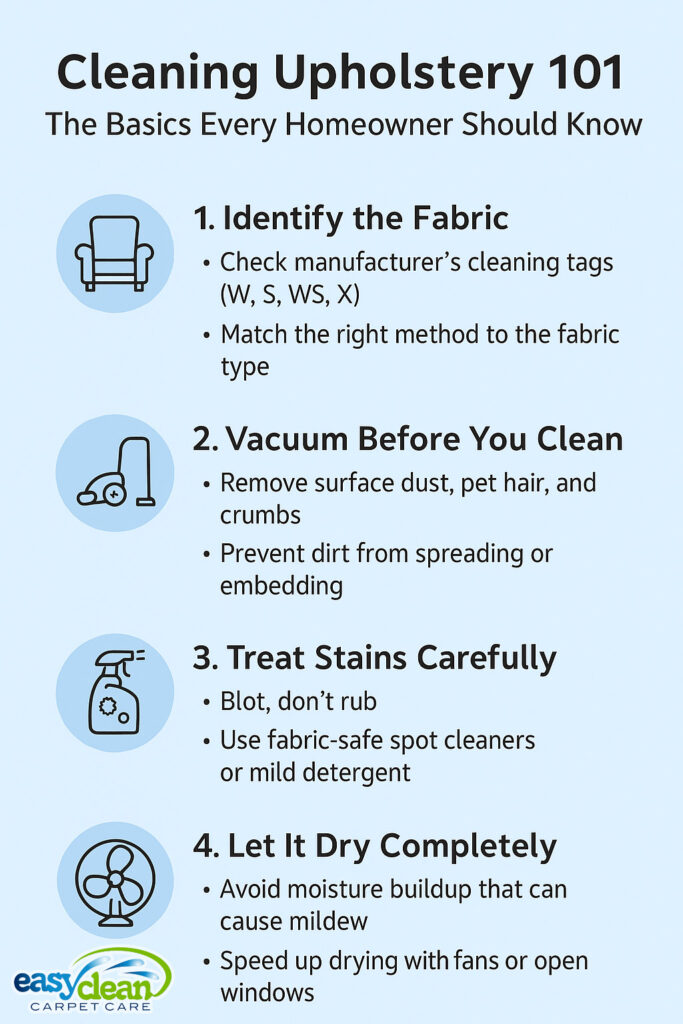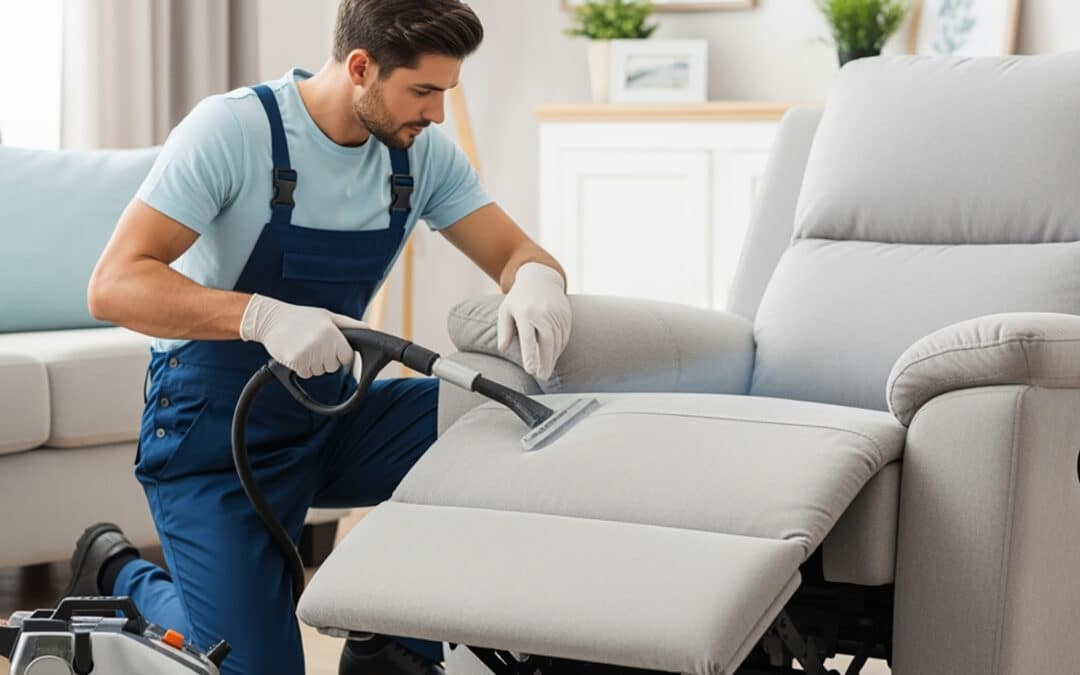Your furniture is one of the most-used features in your home — and one of the easiest to overlook when it comes to cleaning upholstery. Couches, chairs, and other upholstered pieces quietly collect dust, allergens, body oils, and pet dander every day. Over time, these trapped particles can affect both the look of your furniture and the air quality in your home.
Cleaning upholstery by a professional helps restore your furniture’s appearance and removes deep-down contaminants that ordinary household cleaners can’t reach.
🧠 Key Points
- Regular upholstery cleaning extends furniture life and preserves color and texture.
- Dust and allergens build up in fabric fibers, affecting indoor air quality.
- Different fabrics need different cleaning methods — what works for microfiber may not be safe for cotton or leather.
- DIY spot cleaning helps with small stains, but professional cleaning provides a deeper, safer clean.
- Scheduling professional service once or twice a year keeps furniture looking newer longer.
Why Cleaning Upholstery Matters
Most homeowners vacuum carpets regularly, but few realize that furniture fabrics act as the same kind of filter — trapping dust, pet hair, pollen, and even odors. Without proper cleaning, these pollutants can spread through the air whenever someone sits down.
Professional upholstery cleaning eliminates these trapped particles, helping create a cleaner and healthier living space for your family.
Research from the American Lung Association and NIH studies show that routine deep cleaning reduces allergens and improves overall air quality.
Common Upholstery Fabrics and How to Care for Them
Each type of upholstery material requires its own cleaning technique. Using the wrong products or too much moisture can cause fading, shrinkage, or discoloration.
Microfiber
Durable and stain-resistant, microfiber responds well to gentle brushing and professional steam cleaning. Avoid over-wetting, which can leave marks.
Cotton and Cotton Blends
Comfortable but absorbent — spot-clean small stains with mild detergent and water, and schedule regular deep cleaning for long-term freshness.
Leather
Use specialized leather cleaners and conditioners to keep the surface supple and soft. Avoid harsh chemicals that strip natural oils.
Synthetic Fabrics
Polyester, nylon, and acrylic fabrics handle moisture well but may attract static and lint. Professional hot-water extraction works best for deep cleaning.
Cleaning Upholstery: DIY vs. Professional
While there are plenty of store-bought upholstery cleaners and rental machines, they rarely match the results of professional equipment.
According to Angi’s guide and Martha Stewart’s cleaning experts, professional furniture cleaners use advanced tools and fabric-safe solutions to remove dirt and bacteria without leaving residue behind.
This not only provides a deeper clean but also prevents re-soiling and extends the life of fabrics. DIY cleaning is fine for occasional touch-ups, but professional service ensures your furniture is cleaned safely and thoroughly.
How Often Should You Have Your Upholstery Cleaned?
For most homes, professional upholstery cleaning is recommended every 12 to 18 months. Homes with children, pets, or allergy sensitivities may benefit from professional cleaning every 6–9 months.
The EPA and IICRC standards recommend regular professional maintenance to preserve fabric quality and reduce allergens.
Lifestyle experts at The Spruce and Martha Stewart emphasize that consistent care keeps furniture looking newer and prevents long-term wear.
Regular vacuuming between professional visits helps maintain fabric quality and keeps your home healthier.

Signs It’s Time for a Professional Cleaning
- Fading or dullness in the fabric
- Persistent odors or visible stains
- Increased allergy symptoms
- Uneven wear or discoloration on frequently used cushions
If you notice these signs, it’s time to schedule a professional cleaning before permanent damage occurs.
Cleaning Upholstery for a Healthier Home
Clean furniture isn’t just about appearances — it’s about comfort and well-being. Removing built-up allergens, bacteria, and odors helps improve indoor air quality, making your home a healthier and more comfortable place to live.
For a deeper look at how carpet and upholstery cleaning work together, explore our complete guide: Carpet & Upholstery Cleaning: Your Guide to a Fresher, Healthier Home.
🧽 Cleaning Upholstery: Experience the Easy Clean Difference
At Easy Clean Carpet Care, we treat your furniture with the same level of care we give your carpets. Our certified technicians use advanced cleaning techniques tailored to each fabric type, ensuring the safest and most effective results.
To restore the beauty and comfort of your furniture, visit our
Upholstery Cleaning page or Contact Us to schedule your next cleaning appointment.
❓ Frequently Asked Questions About Cleaning Upholstery
1. How often should I have my furniture professionally cleaned?
For most homes, cleaning upholstery every 12–18 months is ideal. If you have pets, children, or allergy concerns, professional service every 6–9 months helps keep fabrics fresh and allergen-free.
2. Can I clean my upholstery myself?
You can handle small spills or light soil with DIY cleaners, but professional upholstery cleaning reaches deep into fabric fibers to remove dirt, oils, and bacteria that household products often leave behind.
3. Does cleaning upholstery help with allergies or odors?
Yes. Deep cleaning removes pet dander, dust mites, and trapped odors that can trigger allergies and affect indoor air quality. It also leaves your home smelling cleaner and feeling more comfortable.
4. What types of fabrics can be professionally cleaned?
Most upholstery materials — including microfiber, cotton blends, synthetics, and leather — can be cleaned safely when the right method is used. Professional technicians test each fabric first to determine the safest process.
5. How long does upholstery take to dry after cleaning?
Drying usually takes 6–12 hours, depending on fabric type, room temperature, and ventilation. Opening windows or running ceiling fans can help speed up the process.
6. How can I keep my furniture cleaner between professional visits?
Vacuum weekly using a soft brush attachment, treat spills immediately, and rotate cushions to prevent wear patterns. Removing shoes indoors also helps keep fabric cleaner longer.
📚 Additional Resources
- American Lung Association – Carpets and Health
- EPA – Carpets and IAQ in Schools
- NIH – Carpets and Indoor Air Quality
- Angi – DIY or Professional Furniture Cleaning: Which Is Best?
- The Spruce – How Often Should You Clean Carpet?
- Martha Stewart – How to Clean Upholstered Furniture the Right Way
- IICRC S100 Cleaning Standard


Recent Comments